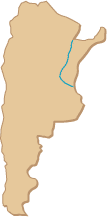Argentina: Introduction
 |
 |
Report prepared by Enrico Barbon and Ann Marie Gorecki, students in BCIT’s Fish, Wildlife and Recreation Program
Geography
Argentina is located in southern South America and borders the South Atlantic Ocean, between Chile and Uruguay. It also borders Bolivia, Brazil and Paraguay. The highest point in Argentina is Cerro Aconcagua at 6,960 m (located in the northwestern corner of the province of Mendoza). The lowest point in Argentina is Laguna del Carbon at -105 m (located between Puerto San Julian and Comandante Luis Piedra Buena in the province of Santa Cruz).
People
In July 2006, the population of Argentina was estimated to be 39,921,833. Ninety-seven percent of the population is Spanish and Italian, mestizo (mixed white and Amerindian ancestry), and Amerindian. Spanish is the official language spoken in Argentina. Other languages include English, Italian, German, and French. Ninety-two percent of Argentine people are Roman Catholic, two percent are Protestant, and two percent are Jewish.
Economy
Argentina benefits from rich natural resources, a highly literate population, an export-oriented agricultural sector and a diversified industrial base. The major industries are food processing, automotive manufacture, consumer durables, textiles, chemicals and petrochemicals, printing, metallurgy, and steel. The currency is the Argentine peso.
 Funded by TEK
Funded by TEK